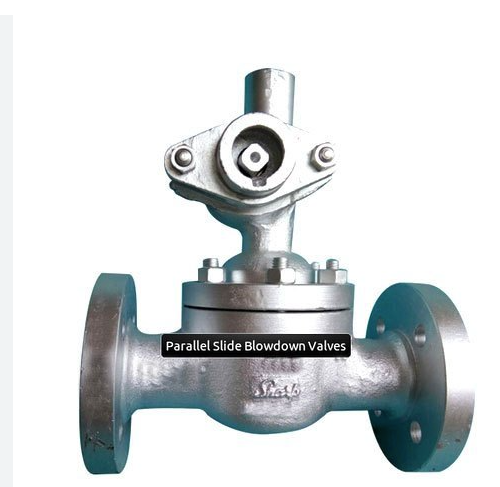Table of Contents
Blowdown Valve important for Industrial Steam Boilers
A blowdown valve is a special type of valve used in Industrial steam boilers to clean the water inside. It’s usually placed at the bottom of the Steam boiler and opened to let the water flow out. The steam pressure inside the boilers helps push the water out forcefully. This fast flow is necessary to carry away any solid impurities that may be present in the water used for the boiler.
The blowdown valve helps get rid of impurities like dirt, scale, and sediment, which can cause various issues if they build up inside the boiler. By removing these impurities regularly, the boiler can work more efficiently and safely.
Understanding Steam Boilers: The Basics of Industrial boiler
Before we dive into blowdown valves, let’s take a moment to understand what steam boiler are and how they work. Boilers are critical components of various industries, including power generation, manufacturing, and heating systems. These vessels are designed to generate steam or hot water, which is then used for various applications.
The process starts by heating water within the boiler to produce steam. The generated steam is then directed through pipelines to power turbines, heat buildings, or support industrial processes. However, during the steam generation process, impurities, dissolved solids, and contaminants can build up in the boiler water. This accumulation can lead to reduced efficiency, increased corrosion, and even dangerous operating conditions.
Importance of Blowdown Valves for Boilers
Now that we understand how blowdown valves function, let’s explore why they are of utmost importance for boiler systems.
1. Boilers Prevention of Corrosion
Blowdown valves play a critical role in preventing boiler corrosion within the boiler system. The accumulation of impurities can lead to the formation of corrosive substances, which can degrade the boiler’s internal components over time. By removing these impurities, blowdown valves help extend the lifespan of the boiler and reduce maintenance costs.
2. Enhanced Efficiency of Steam Boilers
Boilers operating with high concentrations of dissolved solids experience reduced heat transfer efficiency. This can result in higher fuel consumption and energy costs. Blowdown valves assist in maintaining the optimal concentration of impurities, ensuring the Steam boiler operates at maximum efficiency, ultimately leading to cost savings.
3. Steam Industrial boiler Safety Assurance
Safety is a paramount concern when it comes to Steam Industrial boilers. The accumulation of impurities can lead to the formation of sediment and scale, which may obstruct critical parts of the boiler and impede proper functioning. Regular blowdown prevents such obstructions, ensuring safe and reliable operation.
4. Industrial Boiler Compliance with Regulations
In many regions, there are strict regulations governing the operation and maintenance of boilers. These regulations often include requirements for blowdown procedures and discharge limits for impurities. By utilizing blowdown valves and following proper blowdown practices, boiler operators can comply with these regulations and avoid penalties.
Understanding Blow Down Valves
What is a Blow Down Valve?
A blow down valve, also known as a blow-off valve or blowdown cock, is a vital component used in piping systems and pressure vessels. It is designed to control the release of pressurized fluids or gases from a system in a controlled manner. The valve is primarily used to reduce and regulate pressure levels within a system, preventing any potential damage or hazardous situations.

How Does a Blow Down Valve Work?
Blow down valves operate by allowing the controlled release of fluid or gas when pressure levels exceed the predetermined limits. When the pressure within a system rises beyond the set threshold, the blow down valve is triggered, opening a pathway for the pressurized medium to escape. This controlled release helps maintain safe operating conditions within the system, preventing any excessive pressure build-up that could lead to equipment failure or accidents.
Types of Blow Down Valves
There are various types of blow down valves available, each designed to cater to specific applications and industries. Some common types include:
- Conventional Blow Down Valves: These valves are typically manual or semi-automatic and are widely used in small-scale systems. They require human intervention to activate the blow down process.
- Quick Opening Blow Down Valves: Quick opening blow down valves are designed to provide rapid and full opening, allowing for swift discharge of pressurized media. They are often used in situations where a sudden release of pressure is necessary.
- Modulating Blow Down Valves: Modulating blow down valves offer precise control over the rate of discharge. They are commonly used in large-scale industrial systems that require continuous monitoring and adjustment of pressure levels.
The Importance of Blow Down Valves
Blow down valves serve multiple purposes and offer several benefits in industrial processes. Let’s explore some key reasons why blow down valves are of utmost importance:
- Pressure Relief: Blow down valves provide a reliable means of pressure relief in systems where pressure fluctuations are a concern. By releasing excess pressure, blow down valves help maintain safe operating conditions, preventing potential equipment damage and ensuring worker safety.
- Preventing Equipment Failure: Excessive pressure can have detrimental effects on various components within a system, leading to premature wear and tear or even catastrophic failure. Blow down valves help prevent such issues by maintaining pressure levels within acceptable limits.
- Enhancing Efficiency: By effectively regulating pressure levels, blow down valves contribute to the overall efficiency of a system. They help optimize performance, reduce energy consumption, and extend the lifespan of equipment, ultimately leading to cost savings.
- Safety Assurance: Blow down valves play a crucial role in ensuring the safety of personnel and the surrounding environment. By controlling pressure within safe thresholds, they minimize the risk of accidents and potential harm caused by overpressurization.
Implementing Blow Down Valves: Best Practices
When it comes to implementing blow down valves in your industrial processes, it’s essential to follow best practices to maximize their effectiveness. Here are some key considerations:
1. Proper Sizing and Selection
Ensure that blow down valves are sized correctly based on the specific requirements of your system. Factors such as flow rate, operating pressure, and temperature should be taken into account during the selection process. Consulting with experienced engineers or valve manufacturers can help you determine the most suitable blow down valve for your application.
2. Regular Maintenance and Testing
To ensure optimal performance and longevity of blow down valves, regular maintenance and testing are imperative. Follow manufacturer guidelines for maintenance schedules and inspection procedures. Regularly test the blow down valves to verify their functionality and confirm that they are operating within the desired pressure range.
3. Integration with Safety Systems
Integrating blow down valves with safety systems, such as pressure relief devices and alarms, can provide an additional layer of protection. This ensures that if the blow down valve fails or malfunctions, there are backup mechanisms in place to prevent hazardous situations.
4. Training and Education
Proper training and education of personnel involved in the operation and maintenance of blow down valves are crucial. Ensure that employees are well-versed in the functionality, operating procedures, and safety protocols associated with blow down valves. This will help minimize the risk of errors or mishaps during routine operations.
Blow down valves are indispensable components in various industries, offering vital pressure regulation and safety functions. Understanding their functionality, benefits, and best practices for implementation is essential for optimizing industrial processes and ensuring the well-being of personnel and equipment. By following the guidelines provided in this article, you can make informed decisions regarding blow down valves and ensure their efficient operation within your systems.
Buy Boiler Spare Parts at the Best Price
Thermodyne Boilers supplies 100+ Industrial Boiler Parts all over India. Contact our sales team & send your requirement to get prices & discounts
Blowdown Valve important for Steam Boilers FAQ
A boilers blowdown valve is a valve that is used to remove sediment and impurities from a boiler. It is typically located at the bottom of the boiler and is opened periodically to drain out the dirty water.
The function of a Steam boilers blowdown valve is to remove sediment and impurities from the boiler. This is important for maintaining the efficiency and safety of the boiler. Sediment and impurities can build up in the boiler over time and can cause a number of problems, including
* Reduced heat transfer efficiency
* Increased corrosion * Increased risk of fire
There are two main types of boilers blowdown valves: manual and automatic.
Manual blowdown valves are operated by hand. They are typically used in smaller boilers where the amount of blowdown water is not very large.
Automatic blowdown valves are operated by a sensor that monitors the water level in the boiler. They are typically used in larger boilers where the amount of blowdown water is more significant.
The frequency of opening a Industrial boilers blowdown valve will depend on the size and type of boiler, as well as the operating conditions. However, it is generally recommended to open the valve every 8 to 12 hours.
There are a few signs that a boiler blowdown valve may need to be replaced, including:
The valve is leaking
The valve is difficult to operate
The valve is not opening or closing properly
To open a manual blowdown valve, simply turn the handle clockwise. To open an automatic blowdown valve, check the instructions that came with the valve.
To close a manual boiler blowdown valve, simply turn the handle counterclockwise. To close an automatic blowdown valve, check the instructions that came with the valve.
When working with a boiler blowdown valve, it is important to follow these safety precautions:* Wear safety glasses and gloves. * Make sure the valve is properly closed before working on it. * Dispose of the blowdown water properly.
The environmental impacts of boiler blowdown can vary depending on the type of boiler and the amount of blowdown water. However, in general, blowdown water can contain harmful pollutants, such as heavy metals and chlorides. These pollutants can be released into the environment when the blowdown water is disposed of.
Boiler blowdown valves are an important part of boiler maintenance. By following the safety precautions and recommendations above, you can help to ensure that your boiler is operating safely and efficiently.
